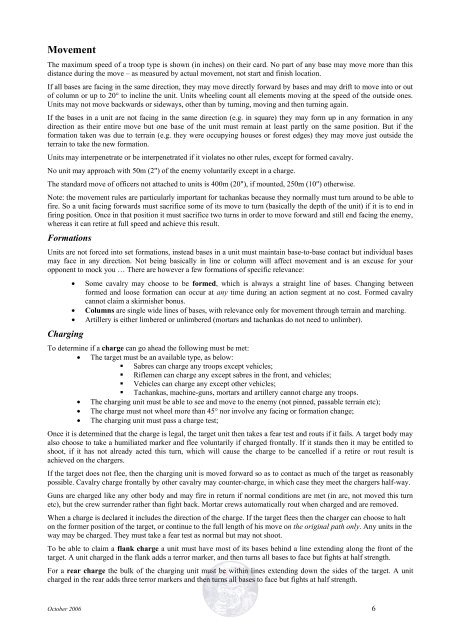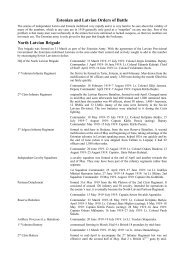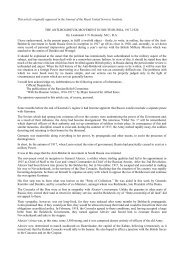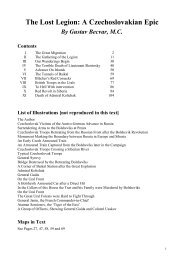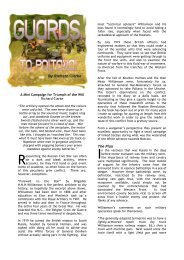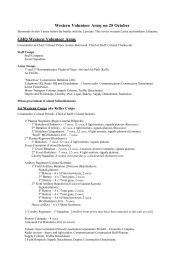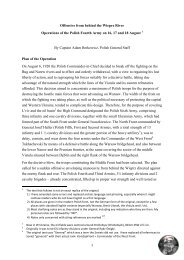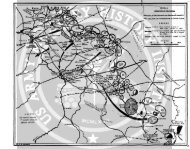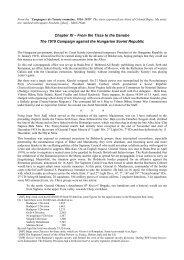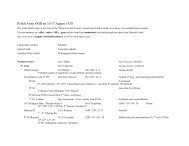Create successful ePaper yourself
Turn your PDF publications into a flip-book with our unique Google optimized e-Paper software.
Movement<br />
The maximum speed of a troop type is shown (in inches) on their card. No part of any base may move more than this<br />
distance during the move – as measured by actual movement, not start and finish location.<br />
If all bases are facing in the same direction, they may move directly forward by bases and may drift to move into or out<br />
of column or up to 20° to incline the unit. Units wheeling count all elements moving at the speed of the outside ones.<br />
Units may not move backwards or sideways, other than by turning, moving and then turning again.<br />
If the bases in a unit are not facing in the same direction (e.g. in square) they may form up in any formation in any<br />
direction as their entire move but one base of the unit must remain at least partly on the same position. But if the<br />
formation taken was due to terrain (e.g. they were occupying houses or forest edges) they may move just outside the<br />
terrain to take the new formation.<br />
Units may interpenetrate or be interpenetrated if it violates no other rules, except for formed cavalry.<br />
No unit may approach with 50m (2") of the enemy voluntarily except in a charge.<br />
The standard move of officers not attached to units is 400m (20"), if mounted, 250m (10") otherwise.<br />
Note: the movement rules are particularly important for tachankas because they normally must turn around to be able to<br />
fire. So a unit facing forwards must sacrifice some of its move to turn (basically the depth of the unit) if it is to end in<br />
firing position. Once in that position it must sacrifice two turns in order to move forward and still end facing the enemy,<br />
whereas it can retire at full speed and achieve this result.<br />
Formations<br />
Units are not forced into set formations, instead bases in a unit must maintain base-to-base contact but individual bases<br />
may face in any direction. Not being basically in line or column will affect movement and is an excuse for your<br />
opponent to mock you … There are however a few formations of specific relevance:<br />
Charging<br />
• Some cavalry may choose to be formed, which is always a straight line of bases. Changing between<br />
formed and loose formation can occur at any time during an action segment at no cost. Formed cavalry<br />
cannot claim a skirmisher bonus.<br />
• Columns are single wide lines of bases, with relevance only for movement through terrain and marching.<br />
• Artillery is either limbered or unlimbered (mortars and tachankas do not need to unlimber).<br />
To determine if a charge can go ahead the following must be met:<br />
• The target must be an available type, as below:<br />
Sabres can charge any troops except vehicles;<br />
Riflemen can charge any except sabres in the front, and vehicles;<br />
Vehicles can charge any except other vehicles;<br />
Tachankas, machine-guns, mortars and artillery cannot charge any troops.<br />
• The charging unit must be able to see and move to the enemy (not pinned, passable terrain etc);<br />
• The charge must not wheel more than 45° nor involve any facing or formation change;<br />
• The charging unit must pass a charge test;<br />
Once it is determined that the charge is legal, the target unit then takes a fear test and routs if it fails. A target body may<br />
also choose to take a humiliated marker and flee voluntarily if charged frontally. If it stands then it may be entitled to<br />
shoot, if it has not already acted this turn, which will cause the charge to be cancelled if a retire or rout result is<br />
achieved on the chargers.<br />
If the target does not flee, then the charging unit is moved forward so as to contact as much of the target as reasonably<br />
possible. Cavalry charge frontally by other cavalry may counter-charge, in which case they meet the chargers half-way.<br />
Guns are charged like any other body and may fire in return if normal conditions are met (in arc, not moved this turn<br />
etc), but the crew surrender rather than fight back. Mortar crews automatically rout when charged and are removed.<br />
When a charge is declared it includes the direction of the charge. If the target flees then the charger can choose to halt<br />
on the former position of the target, or continue to the full length of his move on the original path only. Any units in the<br />
way may be charged. They must take a fear test as normal but may not shoot.<br />
To be able to claim a flank charge a unit must have most of its bases behind a line extending along the front of the<br />
target. A unit charged in the flank adds a terror marker, and then turns all bases to face but fights at half strength.<br />
For a rear charge the bulk of the charging unit must be within lines extending down the sides of the target. A unit<br />
charged in the rear adds three terror markers and then turns all bases to face but fights at half strength.<br />
October 2006 6


